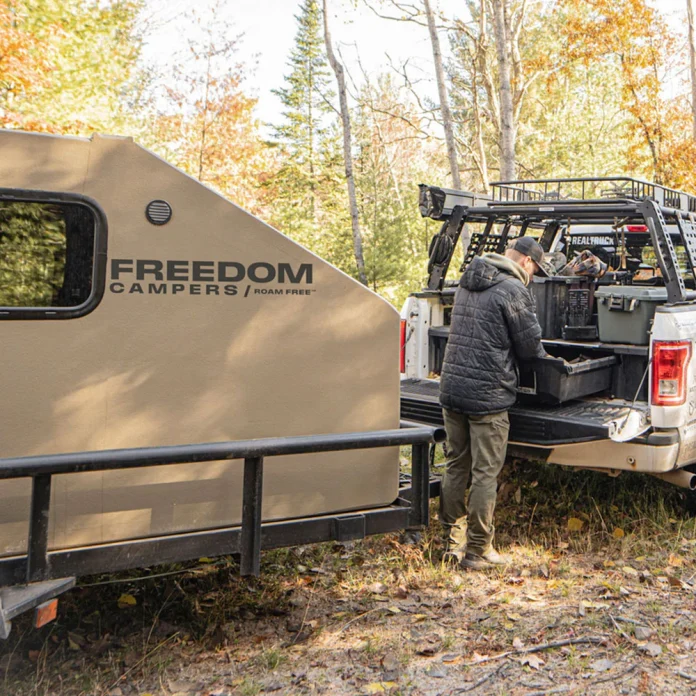There’s a special kind of freedom that comes from building your own trailer, especially when it doesn’t require a second mortgage. If you already own a simple utility trailer, pairing it with the lightweight, ultra-insulated Freedom Camper is one of the most cost-effective ways to craft a capable off-grid adventure rig. Instead of shopping for a large RV or a niche micro-trailer, you can start with the gear you have, add a purpose-built camper shell, and end up with a four-season home on wheels that fits your style of travel.
The Freedom Camper is uniquely suited to this role. It’s designed to live in a pickup bed, a toy-hauler platform, or—crucially for this guide—a flatbed/utility trailer. At just 180–190 pounds depending on size, it’s easy to maneuver during the build, yet it brings serious insulation and weather protection. That means you can focus your budget on smart trailer upgrades—tires, suspension, power, water, and storage—while the camper itself handles the sleeping comfort and shelter you need from the first trip onward.
In this step-by-step guide, you’ll learn how to choose the right trailer, pick the best Freedom Camper size for a trailer mount, bolt it down securely, and outfit your platform with power, water, and storage. We’ll also walk through field-testing and fine-tuning so your new off-grid adventure rig is dialed before a big trip. By the end, you’ll have a clear blueprint to build an adaptable, American-made setup that punches far above its price.
Choose the Right Utility Trailer for the Job
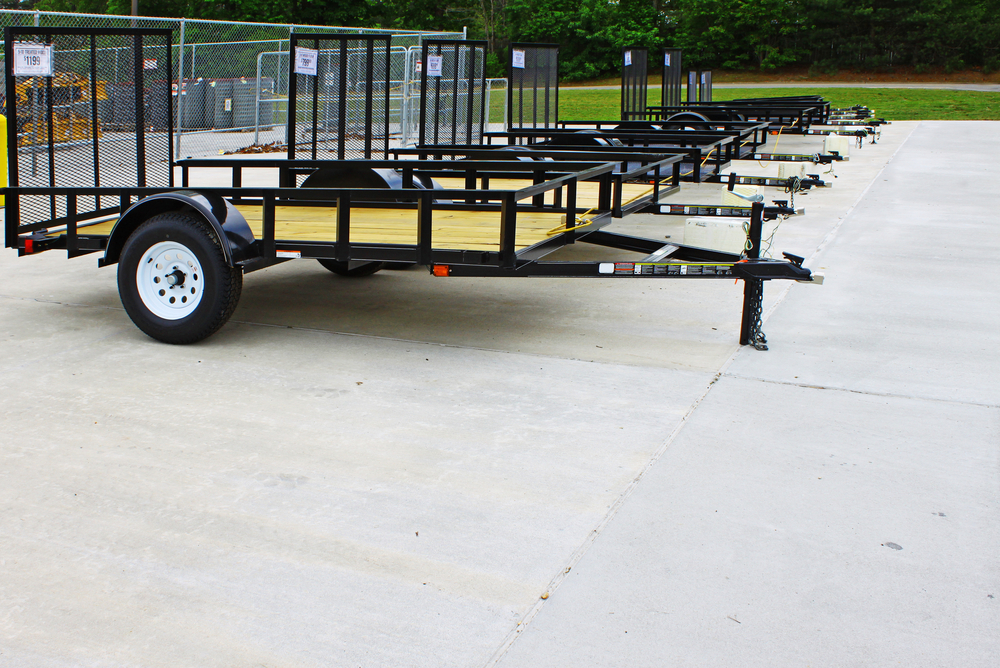
Photo by Barry Blackburn via Shutterstock
Start with the platform. For the Freedom Camper, a flatbed or open-deck utility trailer is ideal because it offers a level, unobstructed surface and easy access to mounting points. As a rule of thumb, a 5×8 trailer is the sweet spot for most Freedom Camper sizes. The 48×89 and 58×89 models are particularly well-suited to 5×8 and larger trailers, with the 48×89 sometimes fitting 4×8 decks (measure to verify). Choosing a trailer that at least matches these footprints will make positioning and fastening far simpler.
Capacity matters. Check the trailer’s Gross Vehicle Weight Rating (GVWR) and payload. The Freedom Camper weighs only ~180–190 pounds depending on size, leaving generous margin for water, batteries, a galley box, recovery gear, and bikes or an ATV. Still, it’s smart to think ahead: a 3,500-lb axle with quality hubs, bearings, and brakes gives you room to grow while maintaining safe stopping performance when your off-grid adventure rig is fully loaded.
Consider ride quality as well. Basic box-store trailers can work, but if you plan to explore washboard backroads, look for ruggedized features: a welded steel frame, leaf springs in good condition or upgraded suspension components, and sufficient ground clearance. Large-diameter wheels (15″ or larger) with all-terrain tires dramatically reduce heat and stress on bearings at highway speeds and smooth out chatter on gravel. These choices protect both the trailer and the camper shell you’ll be relying on for shelter.
Lastly, think about deck height and tongue length. A lower deck makes entry/exit easier and keeps the center of gravity down for stability. A longer tongue improves tracking and gives space for a tongue box holding batteries or a propane cylinder, keeping weight forward of the axle—an important detail for a stable-towing off-grid adventure rig.
Select the Best Freedom Camper Model for Trailer Mounting
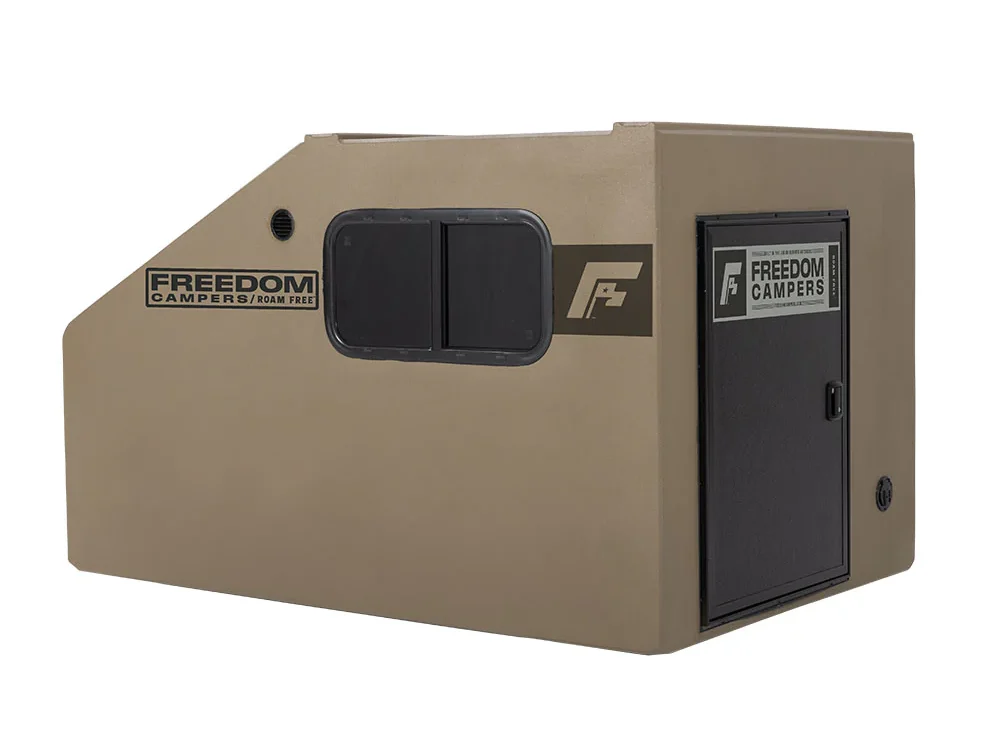
All four Freedom Camper sizes are built with the same robust construction and insulation, so the “best” model comes down to how you want your trailer layout to function. The 58×89 is the most popular because it provides extra interior length and width for two adventurers and gear, and it’s directly compatible with 5×8 trailers and larger. If you value elbow room and a little storage space inside for duffels, this model fits the bill while keeping overall weight low.
The 48×89 shines for builders prioritizing a narrow footprint and lightest possible build, yet still wanting the longer 89″ interior length for taller sleepers. On some 4×8 trailers, it can fit with careful measurement, making it a minimalist’s dream. Meanwhile, the 58×79 and 48×79 models provide compact options when you want to keep the camper shorter on the deck to free up space for a rear gear platform, bike mounts, or a small slide-out kitchen—handy if your off-grid adventure rig needs open deck area for daily camp tasks.
Consider Your Gear
Match size to your gear plan, too. If you’ll carry an ATV, kayaks, or a large cooler on the trailer, the narrower 48″ variants leave more deck real estate beside or behind the camper shell. If your trips center on shoulder-season camping or mountain conditions, the 58″ width offers a roomier sleep system and space to keep extra layers inside overnight so they’re warm and dry. Because the Freedom Camper’s insulation holds comfort down to ~20°F, a slightly larger interior doesn’t penalize you with cold spots the way uninsulated shells do.
Finally, keep towing dynamics in mind. Longer campers (the 89″ length) pair nicely with longer tongue trailers, helping with fore-aft weight distribution and creating room for a tongue storage box. Shorter campers (the 79″ length) enable a compact, nimble off-grid adventure rig that can snake through tight forest roads and stash easily in a garage or side yard between trips.
Mounting the Freedom Camper on Your Utility Trailer

Freedom includes a dedicated Trailer Mounting Kit (six plates, six bolts, six washers, six nuts), which is exactly what you want for a permanent, rattle-free installation. Compared to ratchet straps, bolting through the deck provides a lower profile, better weight transfer into the trailer frame, and zero worry about strap stretch or abrasion on bumpy tracks. Plan your mount locations before drilling: aim to catch structural crossmembers whenever possible, and mark clear access points for tightening hardware during periodic inspections.
Positioning is simple: center the camper laterally on the deck and bias it slightly forward to put 10–15% of total trailer weight on the tongue. That tongue weight range is a key factor in eliminating sway at speed. With the Freedom Camper’s 180–190-lb weight, this is easy to achieve, even with a modest tongue box and a pair of Group 27 batteries up front. Once aligned, clamp the camper rails in place, drill pilot holes through the deck and frame plates, then step up to final bolt size for a snug, secure fit.
Securing the Trailer
Use large fender washers or backing plates underneath to spread the load. Add a thin layer of closed-cell gasket material between the camper base and the deck if you expect a lot of rain or river crossings; it reduces water intrusion and dampens vibration. After torquing hardware to spec, paint exposed metal and apply anti-corrosion spray to drilled edges. A tidy install like this turns the trailer/camper connection into one rigid structure—exactly what you want from an off-grid adventure rig built to see real miles.
Before your first trip, check coupler fitment, safety chains, and wiring harness routing. If your trailer has a rear ramp or removable tailgate, verify that the door of the Freedom Camper swings/clears without interference. This quick systems check prevents surprises at the trailhead when all you want to do is park, unclip, and start relaxing.
Plan and Optimize Interior Comfort

The insulation is the Freedom Camper’s secret weapon. Where many minimalist shells sweat in cold weather, the Freedom’s proprietary insulation keeps interior temps comfortable even when it’s around 20°F outside. That means a proper sleep system—insulated pad or low-profile mattress—turns the space into a restful sleeping area. Choose bedding that packs small, and consider moisture management: a breathable mattress underlay and a micro-fiber towel go a long way toward keeping condensation in check on shoulder-season trips.
Remember that storage makes small spaces livable. Soft-sided bins sized to the interior width (44″ or 54″ depending on model) slide neatly under a sleeping platform or stack alongside it. Magnetic or hook-and-loop pouches near the door corral headlamps, phones, and chargers. A compact, dimmable LED light strip along the ceiling gives even illumination without harsh glare. These small touches add up so your off-grid adventure rig feels calm and organized even after a long day on the trail.
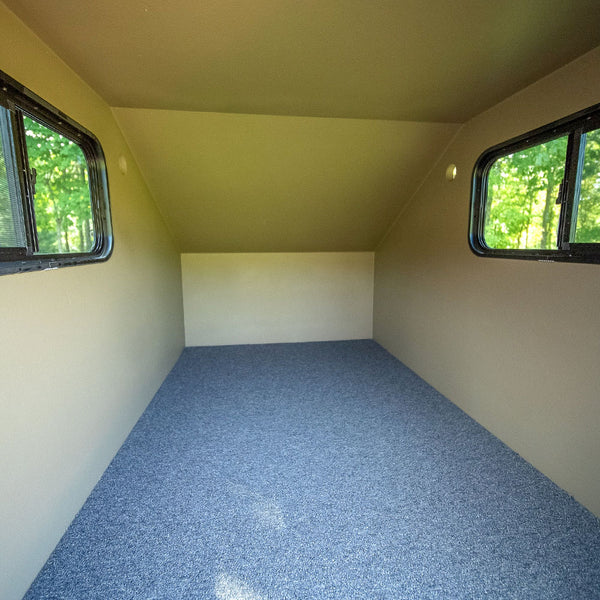
Ventilation matters in every season, too. Crack the Freedom Camper’s side windows to promote crossflow, and pair that with a low-draw 12V fan. In cold conditions, a tiny portable heat source designed for enclosed spaces can take the edge off quickly; keep it safe with a CO detector and always follow manufacturer guidelines. Because the Freedom Camper is so well insulated, you’ll use less energy to maintain comfort than you would with a bare-aluminum box.
Finally, plan for fast transitions. A fold-flat micro-table lets you write, prep food, or tinker with maps inside during bad weather. Keep a “first-in last-out” duffel by the door with layers, beanie, and rain shell—habits like these make your off-grid adventure rig feel effortless when conditions turn.
Add Off-Grid Power and Essentials
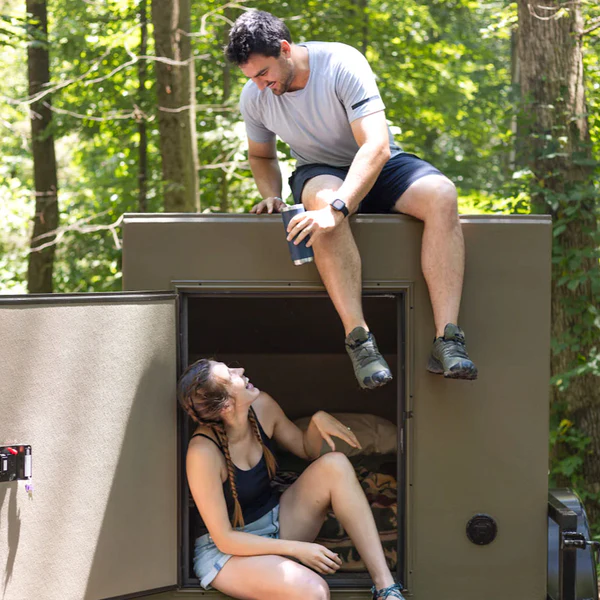
A reliable 12V system transforms your trailer from simple shelter to mission-ready off-grid adventure rig. A practical baseline is a 100–200Ah battery (AGM or LiFePO₄) in a vented tongue box, fused distribution, and a DC-DC charger from the tow vehicle. Add a 100–200W rooftop or deployable solar panel with a reputable MPPT controller, and you’ll keep lights, fans, and devices powered indefinitely on sunny trips.
Water is next. A 7–14-gallon tank mounted low and forward keeps the center of gravity in check; quick-connect fittings make refills and winterization painless. A compact 12V pump feeding a food-grade hose gives you a simple galley at the trailer’s edge. Pair this with a gravity filter or compact purifier and you’ve got safe drinking water without constant town runs—one of the simple pleasures of a well-sorted off-grid adventure rig.
Cooking solutions can stay modular. A slide-out crate with a two-burner propane stove, windscreen, and nesting cookware keeps camp setup fast. Store fuel outside the living space (the tongue box or a lockable jerry can holder) and keep a fire extinguisher within arm’s reach. For multi-sport trips, a rear receiver-mounted rack or crossbars above the deck can carry bikes, skis, or a kayak without blocking the Freedom Camper’s door.
Don’t forget security and recovery. A coupler lock, wheel lock, and a quality hitch pin deter opportunistic theft when you’re away from camp. Stow a compact recovery kit—kinetic strap, shackles, tire plug kit, and a portable compressor—so your off-grid adventure rig can self-rescue from the usual backroad hiccups.
Outfit the Trailer for Off-Road Travel
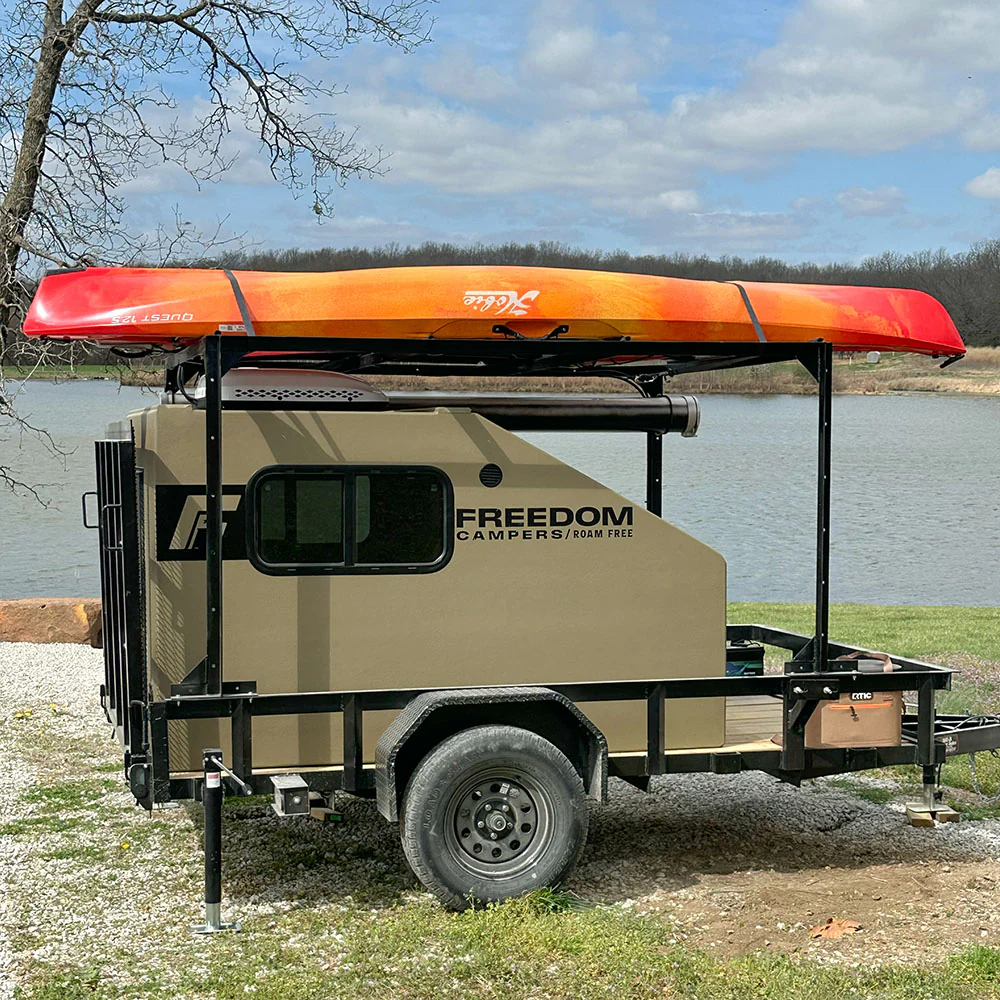
Traction and clearance define how far you can push your trailer. Upgrading to LT all-terrain tires on suitably rated wheels is the single best performance mod you can make. Match or slightly exceed your tow vehicle’s tire diameter to help the trailer roll over washboards and embedded rocks. Fresh, properly torqued lug nuts and balanced wheels protect bearings on long highway approaches—an under-appreciated part of keeping an off-grid adventure rig reliable.
Suspension deserves attention, too. Quality leaf springs with appropriate rate, fresh bushings, and good shocks (if your axle accepts them) tame corrugations and reduce bounce that can fatigue mounts. If you find yourself dragging on departure angles, a modest axle-flip or raised spring perch can help—just be sure to maintain proper geometry and brake line slack. Add robust fenders and mud flaps to shield the Freedom Camper from debris.
Weatherproofing extends longevity. Seal deck penetrations with marine-grade sealant, and coat exposed wood with a durable paint or bedliner-type coating. Loom and secure all electrical runs away from sharp edges. Use stainless hardware where practical. These “unsexy” details make a measurable difference when your off-grid adventure rig spends its life outside in sun, rain, and freeze/thaw cycles.
Finally, think camp ergonomics. A side awning or freestanding tarp creates a dry workspace next to the camper door. Mount a shovel and traction boards where they’re accessible without unpacking the whole trailer. The easier it is to set up and tear down, the more often you’ll say yes to spontaneous weekends—and the more value you’ll get from your build.
Field-Test and Fine-Tune Your Setup
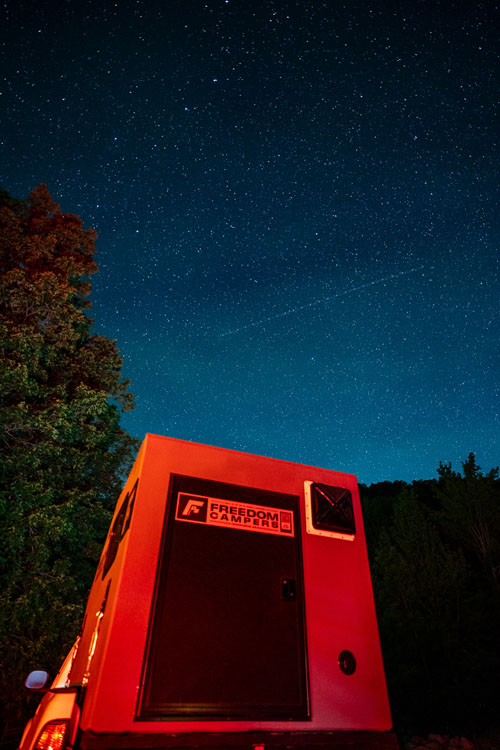
Before a big trip, run a shakedown within an hour of home. Load the trailer as you would for a multi-day adventure and pay attention to balance, tongue weight, and sway. If the trailer feels light up front, shift dense items (water, batteries, tools) forward or consider moving the Freedom Camper a few inches toward the tongue. Small changes can transform how composed your off-grid adventure rig feels at 65 mph.
At camp, time your setup and teardown. Note friction points: Are you moving the same bin three times to reach the stove? Does the door interfere with a bike rack position? These observations guide simple layout tweaks—reversing a bin stack, shifting a rack mount, or adding a second set of tie-downs—so your system becomes second nature.
Electrical testing is equally important. Track daily amp-hours with a battery monitor and see how your solar keeps pace. If you end a day below 50% state of charge consistently, increase panel wattage or adjust charging while driving. The beauty of a modular trailer build is that you can iterate without re-engineering the entire camper shell.
Finish with a post-trip torque check on your mounting hardware, lug nuts, and hitch components. This habit is the hallmark of a seasoned builder and the reason well-maintained off-grid adventure rig setups feel rock-solid for years.
Advantages of the Freedom Camper + Utility Trailer Combo

Value is the headline. The Freedom Camper gives you a four-season sleeping cabin with true insulation—comfortable down to around 20°F—at a fraction of the cost of a full RV. Because it’s so light, you don’t need a heavy tow vehicle. That combination produces a highly capable off-grid adventure rig that’s affordable to buy, fuel, and maintain.
Flexibility is the second act. You can unbolt the camper and use the trailer for weekend chores or leave the camper mounted and reconfigure the open deck area for different trips—bikes one weekend, an ATV the next. The Freedom Camper’s four available sizes (48×79, 48×89, 58×79, 58×89) make it easy to prioritize interior space versus open deck capacity based on your goals.
Durability seals the deal. Proudly built in Lamar, Missouri, the Freedom Camper brings American-made craftsmanship to a space often dominated by thin, uninsulated shells. With thoughtful mounting and sensible trailer upgrades, you’ll have an off-grid adventure rig that shrugs off weather, washboard, and long highway slogs. And because the camper’s core weighs only ~180–190 pounds, strain on trailer components stays low, prolonging service life.
Finally, storage and access are simple. Many builders store the trailer/camper combo in a side yard or standard garage bay. Quick access means more spontaneous trips, and more trips are the real measure of a successful off-grid adventure rig.
Final Thoughts
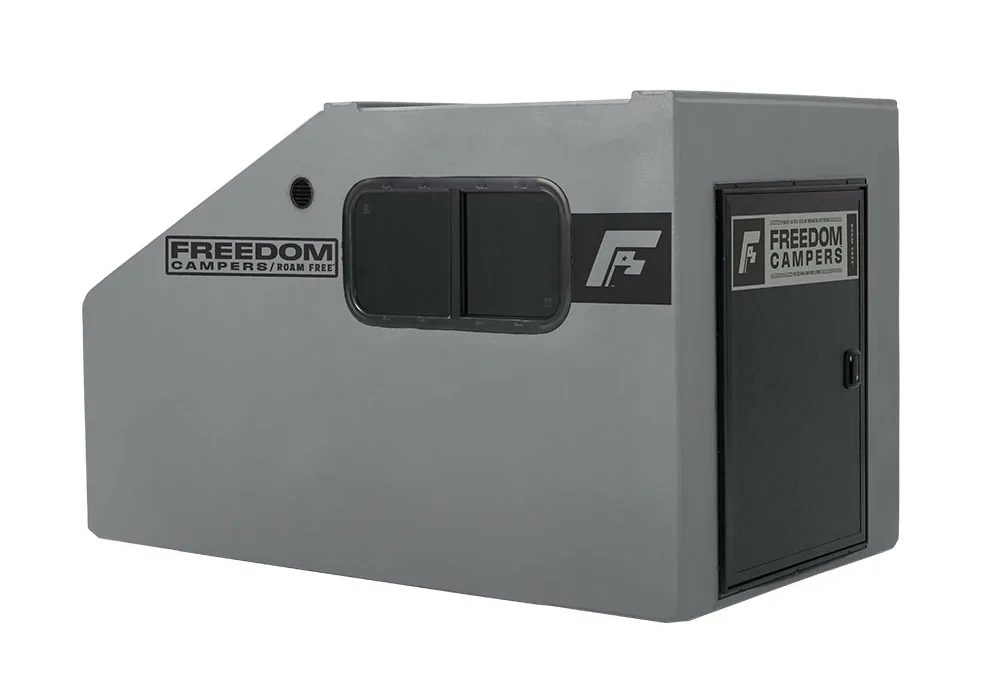
Pairing a utility trailer with the Freedom Camper is an elegant solution to a common problem: how to get four-season comfort, gear capacity, and backroad capability without overspending. The result is a modular off-grid adventure rig that adapts to hunting trips, overnighters at the trailhead, and multi-day explorations down county roads most RVs won’t risk.
Start with the right trailer, choose the Freedom Camper size that fits your travel style, mount it securely, and build out power, water, and storage at a sustainable pace. Every improvement you make will compound—better sleep, faster camp routines, more time exploring. That’s the true return on investment.
When you’re ready, take a short shakedown, make a few tweaks, and then point the hitch toward the horizon. A thoughtfully built off-grid adventure rig doesn’t just take you places—it makes getting there part of the fun.
FAQs
Which Freedom Camper size works best on a 5×8 utility trailer?
The 58×89 is the most popular for a 5×8 deck because it offers generous interior space for two while staying trailer-friendly; the 48×89 also pairs well if you prefer a narrower footprint and longer sleeping length.
Do I need a special mounting system, or can I use ratchet straps?
Use the Trailer Mounting Kit with bolts and plates for a rigid, rattle-free connection. Straps can loosen, chafe, and shift on rough roads, which isn’t ideal for long-term reliability.
How much tongue weight should I aim for to prevent sway?
Target 10–15% of total trailer weight on the tongue. Shift dense gear forward (water, batteries, tools) or slide the camper slightly toward the tongue to hit that range.
Will the Freedom Camper actually keep me warm in cold weather?
Yes. Its proprietary insulation is designed to keep interior temps comfortable even around 20°F when used with an appropriate sleep system and basic ventilation.
What’s the minimum trailer size I can use?
A 5×8 deck is the practical baseline for most builds. The 48×89 can fit some 4×8 trailers with careful measurement, but verify dimensions and overhang clearance before committing.
How much power do I need for weekend trips?
A 100–200Ah battery with a DC-DC charger and 100–200W of solar is a solid starting point for lights, fans, and device charging. Scale up if you add a fridge or winter heating loads.
Can I still use my trailer for hauling when the camper is mounted?
Absolutely. One advantage of this setup is modularity—leave the camper on and use remaining deck space for cargo, or unbolt it and return the trailer to full hauling duty.
What upgrades make the biggest difference off-road?
All-terrain tires, sound suspension components, appropriate ground clearance, and secure mounting hardware are the top four. They improve comfort, control, and durability immediately.
Is the Freedom Camper made in the USA?
Yes. It’s built in Lamar, Missouri, with an emphasis on quality construction and durability.
How heavy is the camper and can one person install it?
Models weigh roughly 180–190 pounds. Two people (or a hoist) make placement safer and more precise, especially when aligning bolt holes for the Trailer Mounting Kit.
Just so you know, some of the cool stuff we mention comes with affiliate links, meaning we earn a commission if you buy (no extra charge to you!). Plus, we occasionally feature sponsored content, but rest assured, we only shout out products we genuinely stand behind.




